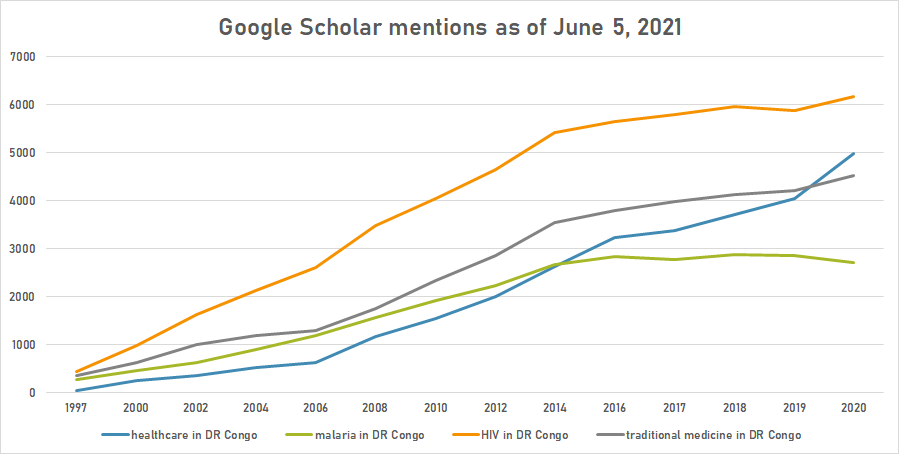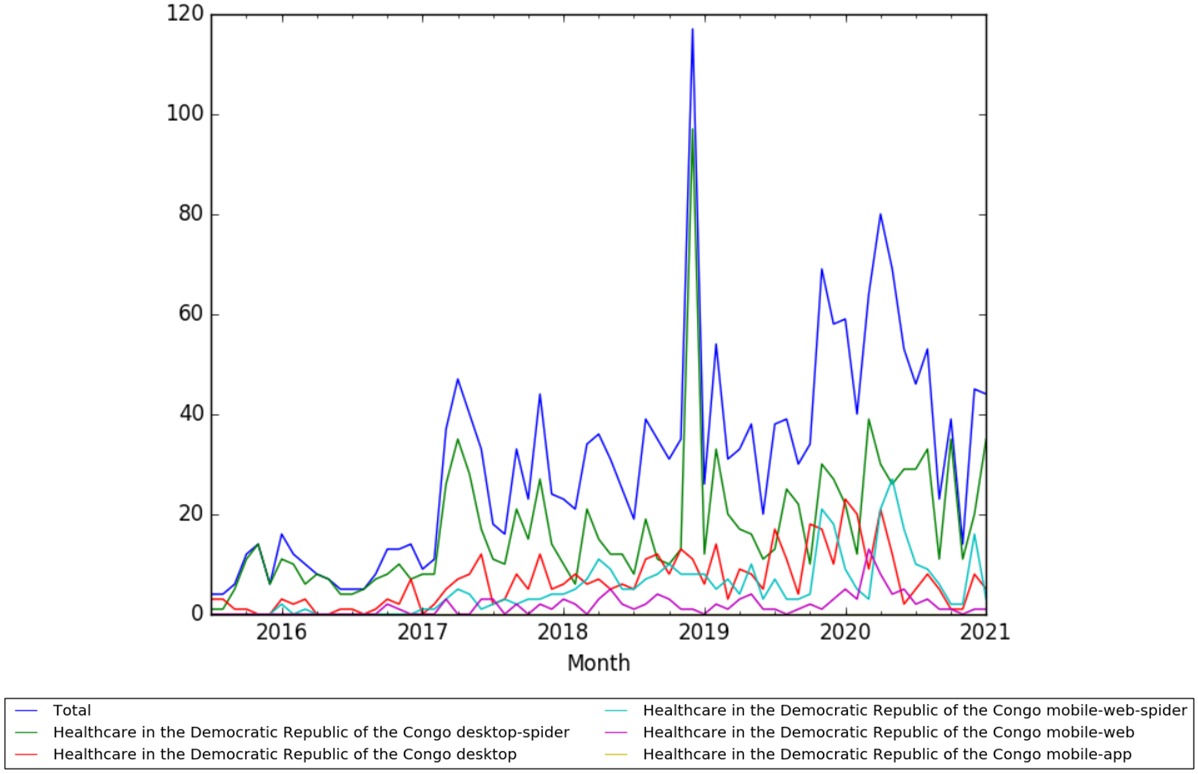Timeline of healthcare in the Democratic Republic of the Congo
Jump to navigation
Jump to search
The content on this page is forked from the English Wikipedia page entitled "Timeline of healthcare in the Democratic Republic of the Congo". The original page still exists at Timeline of healthcare in the Democratic Republic of the Congo. The original content was released under the Creative Commons Attribution/Share-Alike License (CC-BY-SA), so this page inherits this license.
This is a timeline of healthcare in the Democratic Republic of the Congo. Major events such as policies and organizations are described.
Big picture
| Year/period | Key developments |
|---|---|
| 15th century | First contact of Congo area with European medicine comes along with Portuguese explorers.[1] |
| 19th century | Leopold II of Belgium colonizes the Congo and exploits the region as his private property. Millions of people are estimated to die due to exploitation and mistreat by Leopold's agents.[1][2] |
| 20th century | Congo gains autonomy early in the century, and becomes an independent country in the 1960s. Periodic wars, famines and epidemics ravage the health of the population across the century. AIDS epidemic breaks out in the last decades. [1] |
| Recent years | Today, the Democratic Republic of the Congo has one of the worst health indices in the world. Malaria is the greatest threat to health. Water-borne diseases such as diarrhoea, schistosomiasis and cholera are also common. The WHO calculates only 1 doctor and 5 nurses/midwives for every 10,000 people for the period 2000-2010.[3] |
Full timeline
| Year/period | Type of event | Event | Location |
|---|---|---|---|
| 1908 | Background | Congo Free State is placed under rule of Belgium.[1] | |
| 1912 | Organization | Kinshasa General Hospital is founded.[4] | Kinshasa |
| 1925 | Development | Medical missionary Dr. Arthur Lewis Piper first brings and uses tryparsamide, the Rockefeller Foundation’s drug to cure african trypanosomiasis, to the Congo.[5] | |
| 1928 | Organization | Ngaliema Clinic is founded.[6] | Ngaliema |
| 1955 | Discovery | The first case of HIV infection in a human is identified in the DRC.[7] | |
| 1960 | Background | Congo becomes an independent country, with Patrice Lumumba as prime minister and Joseph Kasavubu as president.[1] | |
| 1984 | Campaign | Project SIDA is launched in the DRC as a scientific organization with the purpose of studying AIDS in Africa. Project SIDA scientists are among the first to document heterosexual transmission of AIDS and the existence of AIDS outside of developed countries. It is the largest HIV/AIDS research project on the continent during the 1980s.[8] | Kinshasa (headquarters) |
| 1991 | Organization | Monkole Hospital is founded.[6] | Kinshasa |
| 1994 | Crisis | Cholera epidemic breaks out in the DRC. During the worst period, it is estimated that as many as 3,000 people were dying per day from cholera.[9] | Goma |
| 1997 | Organization | The Institute for Higher Studies in Nursing (ISSI) is established by the Congolese cultural centre for training and development (CECFOR).[10] | Kinshasa |
| 1999 | Organization | Panzi Hospital is founded.[11] | Bukavu, Sud-Kivu |
| 1999 | Organization | International Medical Corps (a global humanitarian nonprofit organization established by volunteer doctors and nurses) begins working in the DRC.[12] | |
| 2006 | Policy | New constitution makes several institutional reforms. Provinces gain the authority to hire and manage the health workforce; develop, support, and supervise health programs consistent with the national health development plan; manage hospital, laboratory, and pharmaceutical services; promote primary health care services at the facility and community levels; and disseminate and enforce health laws and regulations.[13] | |
| 2006 | Campaign | The Congolese government starts to take integrated approach to tackling malaria, including distribution of insecticide-treated bed nets across the country.[14] | |
| 2008 | Organization | Fistula Care Plus (a five-year fistula repair and prevention project from the U.S. Agency for International Development USAID) starts its operations in the DRC.[15] | |
| 2009 | Report | Over 6.7 million cases of malaria are reported in the DRC. Two out of every five deaths among young children are caused by malaria.[3] | |
| 2010 | Crisis | Measles epidemic breaks out in the DRC. Massive campaign vaccinates more than 14 million children.[16] | |
| 2011 | Campaign | A new vaccine to prevent pneumococcal disease is introduced through aid from Global Alliance for Vaccines.[17] | Kinshasa |
| 2011 | Crisis | Between 430,000 and 560,000 cases of HIV are reported in the DRC.[18] | |
| 2012 | Report | 46 percent of the population are reported to have access to an improved drinking water source in the DRC.[19] Also, sanitation coverage is estimated at only 31 percent in 2012.[20] | |
| 2014 | Crisis | Ebola virus disease breaks out in the DRC. 49 deaths are reported.[21] | |
| 2016 | Report | Life expectancy in the DRC is estimated at 57.32 years, being ranked 205th out of 228 political subdivisions.[22] |
Numerical and visual data
Google Scholar
The following table summarizes per-year mentions on Google Scholar as of June 5, 2021.
| Year | healthcare in DR Congo | malaria in DR Congo | HIV in DR Congo | traditional medicine in DR Congo |
|---|---|---|---|---|
| 1997 | 45 | 258 | 426 | 355 |
| 2000 | 236 | 446 | 981 | 624 |
| 2002 | 342 | 625 | 1,620 | 987 |
| 2004 | 514 | 891 | 2,130 | 1,180 |
| 2006 | 623 | 1,180 | 2,610 | 1,280 |
| 2008 | 1,160 | 1,550 | 3,480 | 1,750 |
| 2010 | 1,530 | 1,910 | 4,040 | 2,330 |
| 2012 | 2,000 | 2,230 | 4,640 | 2,860 |
| 2014 | 2,620 | 2,660 | 5,420 | 3,540 |
| 2016 | 3,220 | 2,830 | 5,650 | 3,790 |
| 2017 | 3,380 | 2,770 | 5,780 | 3,970 |
| 2018 | 3,710 | 2,870 | 5,950 | 4,120 |
| 2019 | 4,040 | 2,850 | 5,880 | 4,210 |
| 2020 | 4,980 | 2,700 | 6,170 | 4,510 |

Wikipedia Views
The chart below shows pageviews of the English Wikipedia article Healthcare in the Democratic Republic of the Congo on desktop, on mobile-web, desktop-spider, mobile-web-spider and mobile app, from July 2015 to January 2021.[23]

See also
References
- ↑ 1.0 1.1 1.2 1.3 1.4 "Democratic Republic of Congo profile - Timeline". Retrieved 11 October 2016.
- ↑ "King Leopold's legacy of DR Congo violence". Retrieved 12 October 2016.
- ↑ 3.0 3.1 "Poverty & Healthcare". Retrieved 10 October 2016.
- ↑ "In the Heart of Africa, Darkness". Retrieved 10 October 2016.
- ↑ Klingman, Jack (1994). "Arthur Lewis Piper, M.D.: A Medical Missionary in the Belgian Congo". Journal of Community Health. 19 (2): 125–146. doi:10.1007/BF02260364.
- ↑ 6.0 6.1 "Monkole and Ngaliema: Two referral hospitals in DRC". Retrieved 10 October 2016.
- ↑ "The History of HIV". Retrieved 11 October 2016.
- ↑ "AIDS: the Early Years and CDC's Response". Retrieved 10 October 2016.
- ↑ Echenberg, Myron. "Africa in the Time of Cholera: A History of Pandemics from 1817 to the Present". Retrieved 10 October 2016.
- ↑ "Institut Supérieur en Sciences Infirmières (ISSI)". Retrieved 10 October 2016.
- ↑ "Panzi Hospital". Retrieved 10 October 2016.
- ↑ "International Medical Corps". Retrieved 11 October 2016.
- ↑ "HFG at Work in the Democratic Republic of the Congo". Retrieved 11 October 2016.
- ↑ "Malaria still biggest killer". Retrieved 12 October 2016.
- ↑ "Fistula Care". Retrieved 11 October 2016.
- ↑ "Democratic Republic of Congo: Condition still critical". Retrieved 12 October 2016.
- ↑ McNeil Jr, Donald G. (11 April 2011). "Congo, With Donors' Help, Introduces New Vaccine for Pneumococcal Disease". The New York Times.
- ↑ "UNAIDS REPORT ON THE GLOBAL AIDS EPIDEMIC 2010" (PDF). Retrieved 12 October 2016.
- ↑ ="Issues in managing water challenges and policy instruments: Regional perspectives and case studies" (PDF). International Monetary Fund. 2015. Retrieved 12 October 2016.
- ↑ "UN Data. Democratic Republic of Congo". Retrieved 2016-05-27.
- ↑ "EBOLA RESPONSE ROADM AP SITUATION REPORT" (PDF). Retrieved 10 October 2016.
- ↑ "Life Expectancy". Retrieved 10 October 2016.
- ↑ "Healthcare in the Democratic Republic of the Congo". wikipediaviews.org. Retrieved 24 February 2021.
Category: Health in the Democratic Republic of the Congo Category:Health-related timelines